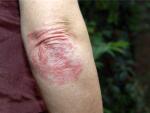AK can develop as the result of being out in the sun too much or from using tanning beds frequently. Without treatment, people who have AK tend to be at a higher risk of developing squamous cell carcinoma, which can be an invasive form of skin cancer.
This article will look at the symptoms, causes, risk factors, and treatment for AK.
What is actinic keratosis?

Also called solar keratosis, AK involves precancerous skin patches that form on areas exposed to the sun, such as the shoulders, scalp, or lips.
Areas with AK can be dry, scaly, or crusty in texture. They can range in color from white to pink and red. Many people can feel the areas of AK more than they can see them. If one AK area appears, it is likely more will develop.
Symptoms of actinic keratosis
Symptoms of AK include:
- dry, rough skin area that is pink, red, or white
- raised or bumpy area on the skin
- raw and tender skin patch that is painful to the touch
- itchiness with burning or pricking sensation
- skin patch bleeding
What does actinic keratosis look like?
AK typically appears as a small dry, crusty, or scaly skin patch. Some areas with AK are flat, while others are raised. They can be red, pink, white, flesh-toned, light or dark tan, or a combination of these colors.
At first glance, they may look like age spots, a rash, or pimples. They typically appear on the skin of the hands, forearms, neck, shoulders, face, and ears, as well as the lips and scalp.
Risk factors for actinic keratosis
The single most important risk factor for developing AK is chronic, unprotected exposure to UV rays from the sun or indoor tanning.
In addition, the following factors can also increase your risk of developing actinic keratosis:
- bald scalp or thinning hair, especially if you don’t use sunscreen or wear a protective hat while in the sun
- UV exposure when living in sunny regions,
closeness to the equator can increase your AK risk Trusted Source PubMed Central Highly respected database from the National Institutes of Health Go to source - skin with less pigment
- light-colored eyes
- red or blond hair
- age, with people 40 and older often more likely to have AK
- more frequent AK occurrence in males than females
- weakened immune system
- organ transplant recipient
- inherited conditions including Bloom syndrome, Rothnord-Thomson syndrome, and xeroderma pigmentosum
Diagnosis of actinic keratosis
If you suspect you have AK, it is important to contact a dermatologist as soon as possible for evaluation. Your dermatologist will take a full medical history and perform a thorough skin exam.
There are no diagnostic tests to confirm AK. Dermatologists can diagnose AK areas by looking at them, along with taking your health history and any risk factors into account.
Treatments for actinic keratosis
The most common treatment for AK is removing the affected area with AK. However, the full scope of treatment for AK will depend on how many spots there are, what they look like, where they are, your age, and overall health condition.
In some cases, your dermatologist may use a combination of the following treatments to remove your AK skin areas:
Surgical procedures
Doctors typically perform these procedures if there is just one area of AK or the affected area is in an isolated spot. They include:
- chemical peels
- cryosurgery, which involves freezing off the area
- laser surgery
- curettage and desiccation, which involves scraping or shaving off the area, followed by heat application to destroy any AK cells and cauterize the area
Topical treatments
In some cases, doctors can apply creams and gels to the affected skin to treat the AK. These include:
- 5-fluorouracil (Carac, Efudex, Fluoroplex), a type of topical chemotherapy to destroy the AK cells
- diclofenac (Solaraze), a hyaluronic acid, combined with an anti-inflammatory to remove the AK area and heal the skin
- imiquimod (Aldara, Zyclara), a type of immunotherapy that encourages the body’s immune system to clear out precancerous cells
- tirbanibulin (Klisyri), which can eliminate the AK skin cells
Photodynamic therapy
Photodynamic therapy involves applying a light-sensitizing agent to the skin, then directing blue or red light to the area to elinate the skin cells. DDoctors use this procedure as a one-and-done treatment for numerous AK areas on the face and scalp.
Outlook
With early diagnosis, doctors can successfully remove AK areas. If your dermatologist removes an AK area, they may prescribe a schedule of regular skin exams to look for new AK areas so they can treat them right away.
If left untreated, AK can progress into skin cancer. Almost anyone with AK can be at higher risk of skin cancer because AK can evolve into squamous cell carcinoma.
Only 5–10% of AK areas turn into skin cancer. However, the majority of squamous cell carcinomas begin as AK.
Click here to learn more about skin cancer.
Prevention of actinic keratosis
The best prevention for AK is to limit UV exposure. Anytime you expose yourself to UV rays — both indoors or through windows — apply a broad-spectrum sunscreen to your skin and face. You also need sunscreen, even if it is cloudy outside.
Then, remember to reapply according to the sunscreen’s instructions. Wear sun protective clothing, hats, and sunglasses. When possible, stay in the shade. It is a good idea to avoid indoor tanning if possible.
In addition to protecting your skin from UV rays, it is important to contact a dermatologist once a year so they can note any changes to or developments of skin growths. AK can be hard to spot initially, so it is helpful to have a dermatologist who can compare areas of change on your skin.
FAQs
The following are some frequently asked questions about AK.
What percent of actinic keratosis turns into cancer?
Just 5–10% of AK areas turn into skin cancer.
How serious is actinic keratosis?
AK can be a precursor to skin cancer, so it is important to have a doctor treat it as soon as possible.
What is the best treatment for actinic keratosis?
Most doctors will remove AK areas to treat them. However, the exact treatment varies based on the amount, appearance, and location of the AK area, as well as your age and health condition. Treatments range from applying cream on the skin to surgical removal of the AK area.
Does an actinic keratosis go away?
AK will not go away without treatment. If left untreated, AK could evolve into squamous cell carcinoma, a common type of skin cancer.
Summary
AK develops on the skin as the result of UV ray exposure from the sun or indoor tanning. Many dermatologists will remove AK areas because having them can place someone at a higher risk of developing skin cancer. There are many treatments for AK, which often are very successful.
If left untreated, AK could turn into squamous cell carcinoma, a common type of skin cancer. As such, early diagnosis and treatment are important to reduce the risk of complications. Using sunscreen and wearing sun protective clothing can help prevent AK.
If you have an AK, contact a dermatologist every year for a skin check to screen for cancer and areas of the skin at risk of developing into skin cancer.





















